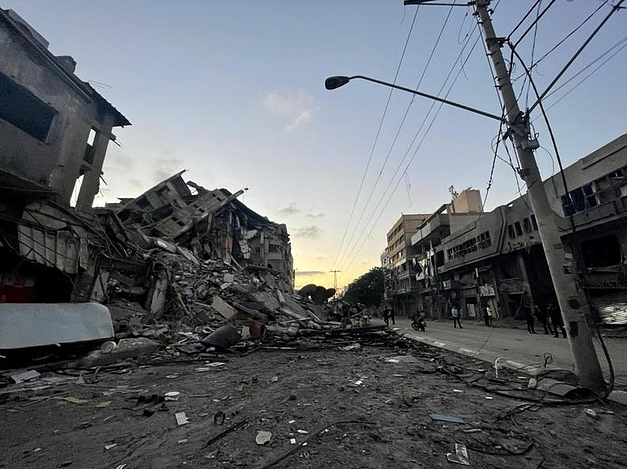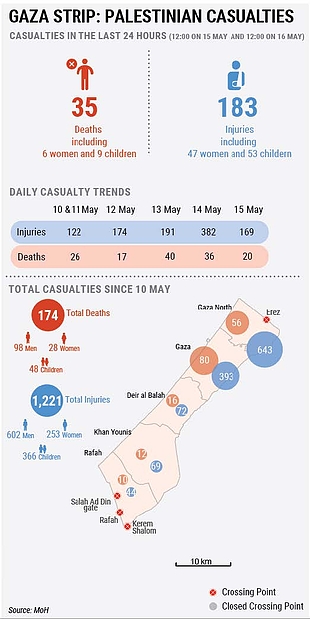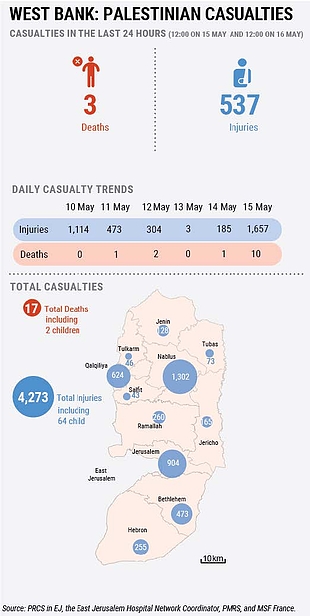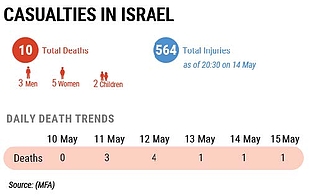Escalation in the Gaza Strip, the West Bank and Israel | Flash Update #6 as of 12 :00 16 May 2021
- Hostilities between Israeli forces and armed groups in Gaza continued, resulting in mounting casualties. Between 10 May and 12:00 on 16 May, 174 Palestinians were killed in Gaza and 1,221 injured, according to the Ministry of Health (MoH) in Gaza.
- Hostilities have also resulted in significant additional displacement of Palestinians, with over 38,000 internally displaced persons (IDPs) seeking protection in 48 UNRWA schools across Gaza. Over 2,500 people have been made homeless due to the destruction of their homes.
- Widespread demonstrations continued across the West Bank, including in East Jerusalem. Two Palestinians were killed by Israeli forces, and one boy died from injuries sustained four days previously. 537 Palestinians were injured in clashes with Israeli forces.
- In Israel, ten people have died so far and hundreds have been injured, based on official data.
- Referring to the deteriorating humanitarian situation in Gaza, the Humanitarian Coordinator, Lynn Hastings, has appealed to “the Israeli authorities and Palestinian armed groups (to) immediately allow the United Nations and our humanitarian partners to bring in fuel, food, and medical supplies and to deploy humanitarian personnel. All parties must always adhere to international humanitarian and human rights laws.”

Situation overview
 Overnight, Israeli forces carried out over 100 strikes on multiple locations across the Gaza Strip, reportedly targeting armed groups and related infrastructure, private, residential and public buildings and the residences of senior Hamas political and military figures. Palestinian armed groups continued extensive firing of rockets and mortars into Israel, including on the Tel Aviv metropolitan area, with many intercepted by the Iron Dome defence system. According to the Israeli authorities, some of the casualties and damage in Gaza may have resulted from Palestinian rockets falling short.
Overnight, Israeli forces carried out over 100 strikes on multiple locations across the Gaza Strip, reportedly targeting armed groups and related infrastructure, private, residential and public buildings and the residences of senior Hamas political and military figures. Palestinian armed groups continued extensive firing of rockets and mortars into Israel, including on the Tel Aviv metropolitan area, with many intercepted by the Iron Dome defence system. According to the Israeli authorities, some of the casualties and damage in Gaza may have resulted from Palestinian rockets falling short.
As of 12:00 16 May, the health authorities in Gaza have reported 174 fatalities, up from 139 in the last reporting period. These include 48 children and 28 women, and injury to 1,221 people, including 366 children and 253 women, since the start of the escalation on 10 May. Among the casualties are residents of homes reportedly struck without prior warning early morning, resulting in the killing of 26 people, including 10 women and eight children, and the injury of about 50 people, mostly women and children. Two senior medical personnel in Gaza are reported to be among the fatalities. The toll is expected to rise as rescue workers and medical teams retrieve fatalities and search for survivors from under the rubble.
Yesterday’s strikes further damaged essential infrastructure, including roads leading to two of the main hospitals, resulting in an additional decline in the public’s access to basic services. According to the Ministry of Public Works and Housing, since the start of the escalation, 94 buildings, comprising 461 housing and commercial units, have been destroyed. In addition, 285 housing units have been severely damaged, and rendered uninhabitable, leaving over 2,500 people homeless, according to the Shelter Cluster. An additional 162 structures have suffered major damage, and 4,814 have suffered minor damage. Power supply across Gaza has reduced to 6-8 hours per day, on average, with a number of feeder lines not functioning, disrupting the provision of healthcare and other basic services, including water, hygiene and sanitation (WASH).
Yesterday, Israeli forces destroyed the Al Jalaa tower in a densely populated area in the centre of Gaza city, after giving a prior warning of about one hour; the destruction was carried out on the grounds that the tower contained infrastructure linked to armed groups. The building housed media offices, including Associated Press and Al Jazeera, and a large number of residences and commercial centres, and is the fourth multi-storey building to be destroyed in Israeli strikes since the start of the escalation.
 The Education Cluster reports that 41 education facilities, including schools, two kindergartens, an UNRWA vocational training centre, MoE directorate and a higher education facility have been damaged since the start of the escalation. As of 15 May noon, four MoH hospitals, two NGO hospitals, two clinics, a health centre and a facility belonging to the Palestine Red Crescent Society (PRCS) have sustained damage.
The Education Cluster reports that 41 education facilities, including schools, two kindergartens, an UNRWA vocational training centre, MoE directorate and a higher education facility have been damaged since the start of the escalation. As of 15 May noon, four MoH hospitals, two NGO hospitals, two clinics, a health centre and a facility belonging to the Palestine Red Crescent Society (PRCS) have sustained damage.
The hostilities have also led to a significant increase in the number of internally displaced persons (IDPs). According to UNRWA, 38,000 people are present in 48 UNRWA schools, primarily for protection purposes, up from 17,000 in the previous reporting period, with some returning home during the day. The Khan Younis governorate witnessed large displacement overnight, with IDPs and host families in need of urgent provision of foodstuffs.
WASH infrastructure has also been severely affected, including wastewater networks, pipelines, water wells and a wastewater pumping station. The North Gaza Seawater Desalination Plant is not operational for the sixth successive day, which undermines the access of about 250,000 people to drinking water. For the third successive day, about 230,000 people from Gaza city and Khan Younis have limited access to piped water, due to increasing power cuts and damaged networks. In the past 24 hours, 220 metres of sewage network was destroyed in Gaza city, serving about 18,000 people. The Juhr Ad Dik landfill area was struck while municipality employees were working there, resulting in one injury and heavy equipment being abandoned. The largest storehouse for agricultural pesticides in Gaza was also bombed, with the authorities assessing if damage has resulted in the pollution of groundwater in the area and negative environmental impact.
Since 10 May, the Israeli authorities have kept the Erez and Kerem Shalom crossings closed, including for humanitarian aid and personnel. All fishing activity remains prohibited off the Gaza coast. The Rafah crossing with Egypt reopened today for the movement of travellers into Egypt after the Muslim holiday of Eid al Fitr while. Also Salah Ad Din gate has re-opened for the movement of goods.
 According to Israeli sources, between 10 May and 14:30 on 15 May, Palestinian armed groups in Gaza fired more than 2,300 rockets and other projectiles into Israel. To date, ten people in Israel, including one soldier, have been killed and hundreds have been injured.
According to Israeli sources, between 10 May and 14:30 on 15 May, Palestinian armed groups in Gaza fired more than 2,300 rockets and other projectiles into Israel. To date, ten people in Israel, including one soldier, have been killed and hundreds have been injured.
In the afternoon and evening of 15 May, widespread demonstrations and clashes between Palestinians and Israeli forces broke out in multiple locations across the West Bank, including East Jerusalem, in commemoration of Nakba Day. Two Palestinians were shot and killed by Israeli forces: one in Tulkarm, and another after allegedly attempting to carry out a ramming attack at a checkpoint near Al Fawwar Refugee Camp. Another boy died after succumbing to live ammunition wounds suffered four days previously in Hebron by Israeli forces. Heavy Israeli military presence and attacks by Israeli settlers were reported across the West Bank, including East Jerusalem.
The reporting period recorded some 537 Palestinian injuries in the West Bank, including East Jerusalem, bringing the total of confirmed injuries since 10 May to 4,273, in addition to 17 fatalities. The Ministry of Education announced the closure of schools in the West Bank for two days (16-17 May), to prevent students from gathering for demonstrations.
Palestinians continue to protest ongoing hostilities in Gaza, and the imminent eviction of Palestinians from the Al Jaouni area of Sheikh Jarrah, where clashes erupted after Israeli forces physically assaulted Palestinian women during protests. Across the West Bank, PRCS treated tear gas and rubber bullet injuries on the ground and transferred live ammunition and critical injuries to hospitals for treatment.
In Israel, inter-communal violence continues.
International law
On 15 May, the UN High Commissioner for Human Rights, Michelle Bachelet, stated that she was “deeply disturbed by the reported use of live ammunition by Israeli Security Forces in the context of protests and clashes in the West Bank, resulting in the death of 10 Palestinians on 14 May alone. Any use of force by the ISF in the West Bank must adhere to the Basic Principles on the use of force and firearms by law enforcement, which state in particular that firearms can only be used against individuals representing an imminent threat to life or of serious injury, and only as a matter of last resort. In a situation of occupation, the unjustified and illegal resort to firearms by law enforcement officials may constitute a war crime.“
Humanitarian response & ongoing needs
Protection
West Bank, including East Jerusalem: Cluster partners are monitoring and documenting suspected violations and providing legal aid and child protection services, as well as mental health and psycho-social support (MHPSS). Twenty-six children have been arrested in the past week, all of whom received legal counselling by cluster partners prior to their interrogation. Since 5 April, 50 Human Rights Defenders, including seven women, have been arrested while participating in peaceful protesting, the majority in Sheikh Jarrah. All are received legal counselling by cluster partners prior to their interrogation. Israeli movement restrictions affecting the Sheikh Jarrah neighbourhood in East Jerusalem continue, reportedly carried out in a discriminatory manner. Groups of Israeli settlers attacking Palestinians in Sheikh Jarrah have also been reported, including the use of live ammunition. Of ongoing concern is the extensive use of live ammunition by Israeli forces towards demonstrators, including in and around Palestinian refugee camps. Since 10 May, in the West Bank, Israeli forces have killed 17 Palestinians, including 2 children.
Gaza: The Cluster continues to assess the impact on vulnerable groups, by monitoring, documenting, and reporting violations of international law. All over Gaza, partners are supporting the provision of assistive devices, physical rehabilitation sessions, and psychosocial first aid for those in need. Partners are preparing dignity kits for women and girls, updating the content and including key messages on Protection against sexual exploitation and abuse (PSEA). Remote psycho-social counselling through hotlines and mobile phones and Explosive Remnants of War (ERW) risk awareness messaging through online platforms and social media are continuing, as well as online information and emergency risk education for community members, including for parents/caregivers on handling stress and caring for children during emergencies.
Health
West Bank, including East Jerusalem:As protests and confrontations continue across the West Bank, including East Jerusalem, cluster partners and community volunteers continue to treat a substantial number of injuries. There is growing concern about the number of live ammunition injuries, as it further threatens the security of medical staff attempting to reach those in need of medical services.
Gaza: As the surge in casualties continues to grow, partners are managing the injured and those in need of remote mental health and psychosocial support. As a result of severe injuries and the COVID-19 pandemic, ICU hospital occupancy is currently at 43 per cent and is expected to rise as the ongoing bombing on Gaza continues. Six hospitals and three clinics have been partially damaged, while one clinic has been completely destroyed.
An estimated 2,500 women will give birth in the next week across Palestine (1,000 in Gaza and 1,500 in the West Bank). The ongoing crisis is impacting women's ability to give birth safely due to damage to health facilities, physical inaccessibility, airstrikes (Gaza) and checkpoints (West Bank). It is essential to ensure continuation of life saving services such as safe delivery and essential newborn care in order to prevent maternal and neonatal morbidity and mortality. Assessments are ongoing to evaluate the impact and emergency needs but require daily updating due to ongoing hostilities.
Shelter
Gaza: According to the Ministry of Public Works and Housing, the bombing has resulted in 94 buildings totally destroyed, comprising 461 housing units and commercial facilities, in addition to 285 housing units with severe damage (uninhabitable), 162 with major damage and 4,814 with minor damage. Partners are trying to carry out detailed damage assessments and support the repair of homes with major damage, giving priority to vulnerable groups. According to UNRWA, as of this morning, at least 37,000 people sought shelter in 48 UNRWA schools, including 23 designated emergency shelters (DES), still not officially open as such. Shelter partners and the Ministry of Social Development (MoSD) have already started supporting some IDP families with Non-Food items, although needs are constantly increasing. Due to damage to power lines and fuel shortages, power supply across Gaza has been reduced to six-eight hours per day on average and in some areas to less than four hours.
Water, Sanitation and Hygiene (WASH)
Gaza: WASH Infrastructure has been severely affected, including water and wastewater networks, 15 water wells, a landfill and several equipment and machinery due to damage, lack of power and difficult access. The service provider and the municipalities are currently carrying out some urgent repairs. Some workers were injured while operating or making repairs, requiring ICRC support to rescue them. The North Gaza Seawater Desalination Plant is still not operational and affecting about 250,000 people. In Beit-Lahia, sewage and solid waste are accumulating in the streets. 230,000 people from Gaza City and Khan Younis are still for the fifth successive day having limited access to piped water, due to increasing power cuts and damage to the networks. Damage to sewage networks is resulting in wastewater flows in the streets in various areas, including Beit Lahia, Gaza City and Khan Younis, and no substantial repairs have taken place yet. The municipality of Gaza appealed for supporting the provision of municipal services which have been disrupted such as solid waste management, water and sanitation networks. In general, there is a reduction of up to fifty per cent in WASH services, with at least 600,000 people severely affected. The largest store of agricultural pesticides in the Gaza Strip was affected by a strike, and authorities are assessing any spillage of chemicals and the environmental impact.
Education
West Bank, including East Jerusalem: The Ministry of Education (MoE) announced the closure of schools in the West Bank, including East Jerusalem, for 16 and 17 May. Students will participate in remote learning for these two days. Cluster partners are scaling up their mental health and psycho-social support (MPHSS) and the monitoring of education-related violations.
Gaza: Some 41 education facilities have been affected so far, including two kindergartens, schools, an UNRWA vocational training centre, one MoE directorate building and a higher education facility have been impacted since the start of the escalation, with reports indicating that a number were directly hit by airstrikes or tank shells. 41 UNRWA schools have been reportedly used as temporary shelters by displaced people. All schools are closed, and distance learning is not yet activated. Approximately 600,000 students will start losing education time as of today, with the end of the Eid al Fitr holiday. Partners are scaling up remote MHPSS interventions, the delivery of emergency education supplies to displaced children, and will start resource mobilization to rehabilitate damaged education facilities.
Food Security
Gaza: Large agricultural areas and various agricultural facilities such as farms, greenhouses, water wells, have been damaged or disrupted, decreasing agricultural production. The situation will be assessed as soon as the situation allows. The closure of Kerem Shalom crossing point has decreased animal fodder availability in the market and the stockpile is almost exhausted, according to the Ministry of Agriculture (MoA). While 600 tons are needed to daily feed poultry and the livestock, privately owned fodder for a few days is reportedly stored at Kerem Shalom and ready to be imported. MoA warns that this situation directly impacts the food security of 17,000 herding households (85,000 people) and risks disrupting the main protein source of the Gaza population. The World Food Programme (WFP) is monitoring the prices and availability of goods in the markets. The price of basic food commodities has remained stable, and the majority of shops have supplies in stock for two months. The need for food and cash support is continuously increasing, and partners are providing at least 51,546 people with immediate assistance through electronic vouchers. Partners are continuing to assess the food needs of displaced people.









